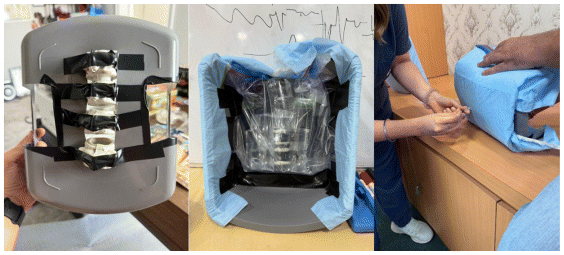
Model 1
Susan Owens1, Rea Mittal1, Serkan Toy1, Manu Madhok1, Katherine Douglass2, and Tania Ahluwalia3
1MD, MPH, Assistant Professor, Department of Emergency Medicine, University of Kentucky, Lexington, United States
2MD, Resident, Department of Pediatrics, Children’s National Hospital Washington, DC, United States
3MEd, PhD, Associate Professor, Departments of Basic Science Education & Health Systems and Implementation Science, Virginia Tech Carilion School of Medicine Roanoke, United States
4MD, MPH, Professor, Department of Emergency Medicine, Children’s Minnesota, Minneapolis, United States
5MD, MPH, Associate Professor, Department of Emergency Medicine, George Washington University, Washington, DC, United States
6MD, MPH, Assistant Professor, Department of Pediatric Emergency Medicine, Children’s National Medical Center, Washington DC, United States
Date submitted: 16-January-2025
Email: Susan Owens (suz.owens2@gmail.com)
This is an open access journal, and articles are distributed under the terms of the Creative Commons Attribution-Non Commercial-Share Alike 4.0 License, which allows others to remix, tweak, and build upon the work non-commercially, as long as appropriate credit is given and the new creations are licensed under the identical terms.
Citation: Owens S, Mittal R, Toy S, Madhok M, Douglass K, and Ahluwalia T. Low-cost lumbar puncture simulators for pediatric neurological emergency training in India. Educ Health 2024;38:91-92
Online access: www.educationforhealthjournal.org
DOI: 10.62694/efh.2025.266
Published by The Network: Towards Unity for Health
Lumbar puncture (LP) is a key procedure for diagnosing and treating many pediatric neurology emergencies. Despite its importance, LP procedural training for EM trainees in India is limited due to the lack of access and cost of simulation models.
We selected a published low-fidelity LP model, modified it to increase portability, and used inexpensive, locally available resources.1 The trainers were designed to replicate key steps of the LP procedure, providing a hands-on experience for trainees that would otherwise be unavailable to them. The development of these LP trainers combined practical design, local materials, and the input of experienced clinicians to create a model that mimicked the anatomical structure and tactile feedback of a real LP procedure.
A medium-sized rectangular plastic bucket was modified to provide palpable iliac crests. In the bucket basin, a plastic skeleton spine was separated and secured to the bucket to mimic the spine’s alignment. This provided palpable spinous processes and the ability to do an LP at the L4/5 or L3/4 interspace. The external portion of the bucket was covered with foam to simulate subcutaneous tissues, and a disposable hospital chuck pad was used to simulate skin. A gallon resealable plastic bag was taped to the internal portion of the bucket to model the ligamentum flavum; a sandwich-sized resealable plastic bag full of water was inserted into the gallon-sized bag to simulate CSF and provide the tactile feedback of collecting CSF during an LP. This model could be used to simulate a supine or upright LP.
A medium-sized box was modified to provide palpable iliac crests. In the center of the box, a plastic skeleton spine was secured to mimic the spine’s alignment, providing palpable spinous processes and the ability to do an LP at the L4/5 or L3/4 interspace. A foam core was used for the inner structure, and the external portion was covered with felt to simulate skin. Balloons filled with water were placed between each interspace to simulate CSF and provide tactile feedback on collecting CSF during an LP. This model could be used to simulate a supine or upright LP.
Pre-intervention data indicated that only one-third of participants (37%, 55/147) had performed an LP on a mannequin, and approximately half (53%, 78/147) had performed an LP on a patient. However, a large portion (45%, 66/147) expressed a lack of competency with LPs on a three-point scale ranging from “not at all competent” to “very competent”. Post-workshop feedback was overwhelmingly positive; 99% of participants reported feeling “somewhat” to “very competent” in LPs (135/137), a significant improvement from the pre-survey data. A McNemar’s test showed a significant improvement in competency levels after the training, p< 0.001.
LP trainers allowed trainees to practice needle insertion techniques and refine their skills in identifying the correct lumbar puncture site. The models also allowed trainees to practice managing complications such as vertebral bone contact. Moreover, the feedback from instructors and facilitators confirmed that the LP trainers facilitated a more standardized training approach, allowing all sites to provide similar training experiences. Additionally, the models’ durability and portability were highlighted as significant advantages, as they made it possible to provide training across multiple sites.
Low-cost, portable LP trainers can address training gaps in pediatric neurological emergency care in resource-variable settings in India. Participant feedback indicates that hands-on simulation-based learning enhances confidence in performing LP. Low fidelity simulation models can be adapted for other resource-limited settings to improve clinical training and further highlights the importance of innovative, low-cost solutions in global health education.
1. Warrington S, Warrington AM. An Inexpensive Adult Lumbar Puncture Task-Trainer with Simulated Cerebrospinal Fluid. HCA Healthcare Journal of Medicine. 2020;1(4):185–190. Published 2020 Aug 29. https://doi.org/10.36518/2689-0216.1083
Crossref PubMed PMC
© Education for Health.
Education for Health | Volume 38, No. 1, January-March 2025